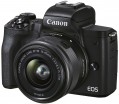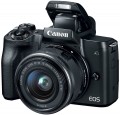Total MP
The total number of individual light sensitive dots (pixels) provided in the camera's sensor. Denoted in megapixels - millions of pixels.
The total number of MPs, as a rule, is greater than the number of megapixels from which the frame is directly built (for more details, see "Effective number of MPs"). This is due to the presence of service areas on the matrix. In general, this parameter is more of a reference than practically significant: a larger total number of MPs with the same size and effective resolution means a slightly smaller size of each pixel, and, accordingly, an increased likelihood of noise (especially at high ISO values).
Effective MP number
The number of pixels (megapixels) of the matrix directly involved in the construction of the image, in fact — the number of points from which the captured image is built. Some manufacturers, in addition to this parameter, also indicate the total number of MPs, taking into account the service areas of the matrix. However, it is the effective number of MPs that is considered the main indicator — it is this that directly affects the maximum resolution of the resulting image (see “Maximum image size”).
A megapixel is 1 million pixels. Numerous megapixels ensures high resolution of the captured photos, but is not a guarantee of high-quality images — much also depends on the size of the sensor, its light sensitivity (see the relevant glossary items), as well as hardware and software image processing tools used in the camera. Note that for small matrices, high resolution can sometimes be more of an evil than a blessing — such sensors are very prone to the appearance of noise in the image.
Sensor cleaning
The presence in the camera of a special mechanism for
cleaning the matrix from dust and other contaminants.
This function is found only in models with interchangeable lenses — "reflex cameras" and MILC (see "Camera type"). When replacing the lens in such cameras, the sensor turns out to be open, and the probability of its contamination is quite high; and extraneous particles on the matrix, at best, lead to the appearance of extraneous artifacts, at worst, to damage to the sensor. To avoid this, cleaning systems are provided. They usually work on the principle of ultrasound: high-frequency vibration "resets" debris from the surface of the sensor.
Note that no cleaning system is perfect — in particular, such systems are “too tough” for condensate, salt deposits and other similar contaminants. So the matrix may still need manual cleaning (ideally, in a service centre). Nevertheless, this function allows you to effectively deal with at least dust, which greatly simplifies the life of the user.
Auto bracketing
Bracketing is called shooting a series of frames, in which in each next frame the shooting parameters (exposure, white balance, focus, etc.) change by a certain amount. This allows, for example, to choose the most successful shot from several options, or to determine the effect of changing the settings in one direction or another. Auto bracketing allows you to take such shots automatically. At the same time, it should be taken into account that the set of parameters changed in the process may differ in different camera models. For example, some devices are able to change only the exposure, others — the exposure and/or white balance, etc.
Connection ports
— USB C. A universal USB interface that uses a Type C connector. USB ports themselves (all types) are used mainly for connecting the camera to a computer for copying footage, managing settings, updating firmware, etc. Specifically The Type C connector is comparable in size to earlier miniUSB and microUSB, but has a reversible design that allows the plug to be inserted in either direction. In addition, USB C often operates according to the USB 3.1 standard, which allows for connection speeds of up to 10 Gbps - a useful feature when copying large amounts of content.
-
HDMI. A comprehensive digital interface that allows you to transmit video (including high resolution) and audio (up to multi-channel) over a single cable. The presence of such a port makes it possible to use the camera as a player: it can be directly connected to a TV, monitor, projector, etc. and view your footage on the big screen. In this case, broadcast capabilities can include not only video playback, but also demonstration of captured photos in slide show mode. HDMI inputs are present in most modern video equipment, and connection is usually not a problem.
Nowadays, there are several versions of the HDMI interface on the market:
- v 1.4. The oldest version currently relevant, released in 2009. However, it supports 3D video, is capable of working with resolutions up to 4096x2160 at a speed of 24 fps, and in Full HD resolution the frame rate can reach 120...fps. In addition to the original v.1.4, there are also improved modifications - v.1.4a and v.1.4b; they are similar in basic capabilities, in both cases the improvements affected mainly work with 3D content.
- v2.0. Significant HDMI update introduced in 2013. In this version, the maximum frame rate in 4K has increased to 60 fps, and support for ultra-wide 21:9 format can also be mentioned. In update v.2.0a, HDR support was added to the interface capabilities; in v.2.0b this function was improved and expanded.
- v 2.1. Despite the similarity in name to v.2.0, this version, released in 2017, was a very large-scale update. In particular, it added support for 8K and even 10 K at speeds up to 120 fps, and also further expanded the capabilities for working with HDR. This version was released with its own cable - HDMI Ultra High Speed; all features of v.2.1 are available only when using cables of this standard, although basic functions can be used with simpler cords.
— Headphone output. Audio output allows you to connect headphones to the camera. As a rule, it is represented by a classic 3.5 mm mini-jack. The presence of such a connector provides the ability to monitor sound during video recording in real time. This is especially important when filming interviews, vlogs and other similar projects.
— Microphone input. Specialized input for connecting an external microphone to the camera. External microphones are significantly superior to built-in microphones in sound quality. Firstly, they are not so sensitive to the camera’s “own” sounds - from buttons, control wheels, focus motors, etc. (and if the microphone uses a long wire and is not attached to the body, these sounds will not be heard at all). Secondly, external microphones themselves have more advanced characteristics. On the other hand, their use is justified mainly for professional video recording; therefore, the presence of a microphone input, as a rule, corresponds to advanced video recording capabilities
Communications
-
GPS module. The camera has a built-in GPS satellite navigation module. In digital cameras, the GPS module is used primarily for setting the so-called. geo-tagging to photos: information about specific geographical coordinates of the shooting location is recorded in the service information about each image. However, the matter is not limited to this, and models with this function can have many additional features - from classic navigation to special programs like a database of points of interest with hints based on the current location.
-
WiFi. A wireless standard originally developed for computer networking, but more recently allowing for direct connection between devices. The ways in which Wi-Fi is used in cameras can vary. Thus, the most popular option is to connect to a smartphone, tablet or other similar device for remote control (see below) and / or transfer footage to an external device. Some cameras have built-in software that allows you to directly connect to the Internet through wireless access points and upload photos and videos to popular network services. And in models running Android (see above), specific features depend only on the installed software and may include full access to social networks through client programs (see below) and even web surfing through a browser.
— Bluetooth. A wireless interface used to communicate with various electronic devices. In cameras, Blu
...etooth is most often used to connect to a computer or laptop and transfer footage; In addition, it allows you to use the direct printing function on printers equipped with Bluetooth. The range of Bluetooth communication is up to 10 m, and the devices do not necessarily have to be in direct line of sight to each other.
- NFC chip. NFC (Near-Field Communication) is a wireless communication technology designed to connect various portable devices with each other at a distance of up to several centimeters. In cameras it plays an auxiliary role, designed to facilitate connection with other devices (smartphones, tablets, etc.) using a longer-range standard (Wi-Fi or Bluetooth). Instead of delving into the settings - looking for devices, connecting them manually - just bring the NFC camera to a gadget equipped with the same chip and confirm the connection request.
— Control from a smartphone. The ability to remotely control the camera using a smartphone, tablet or other similar gadget. The connection between the camera and the control device is usually carried out via Wi-Fi (see above), while a special application is used for control, and the gadget’s screen plays the role of a viewfinder. The specific capabilities of such control can be different - releasing the shutter on command, selecting exposure parameters and other shooting settings, focusing by touch, etc. Often, it is also possible to “drain” the footage onto the control device and, through it, to the Internet. Note that for cameras used with mobile phones (see “Camera Type”), this function is not indicated: such a camera is usually mounted directly on the device, and there is no talk of remote control.flash X-sync
The fastest X-sync speed supported by a digital camera.
This characteristic is relevant only for models equipped with mechanical shutters (see “Shutter type”) and allowing connection of an external flash (see above). Recall that the operation of such shutters is based on the use of two curtains — one opens the matrix, the second, following the first, closes it. At the same time, at low shutter speeds, the shutter speed may not be enough to open the matrix completely — as a result, the exposure is carried out due to the gap between the shutters, which “runs” through the matrix. When shooting with constant lights, this is usually not a problem; however, the duration of the flash pulse is very short, during this time the said gap between the curtains does not have time to pass over the entire area of the matrix, and the picture is only partially illuminated. This means that you can shoot with flash only at shutter speeds at which the shutter opens fully.
The slowest X-sync shutter speed is, in fact, the slowest shutter speed at which the shutter can fully open. In most modern cameras, this figure is about 1/250 – 1/200 of a second, which is quite enough in most cases. And high-end professional models can support X-sync at shutter speeds of 1/1000 or even slower.
Shots per charge
The maximum number of photos that the camera can take on a single battery without recharging/replacing it. In fact, this number usually turns out to be less (sometimes quite noticeable) due to the fact that part of the charge is “eaten up” by the lens mechanics, using the display, changing settings through the menu, etc. Nevertheless, this parameter is a good indicator of the battery life of the device, and different models can be compared with each other.

